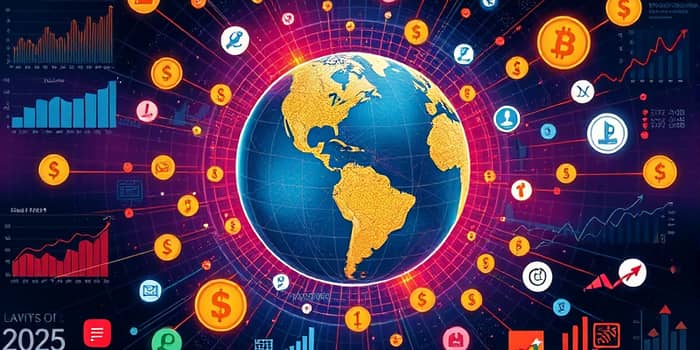
In mid-2025, the global economy stands at a critical juncture, shaped by slowing growth, shifting power dynamics, and rapid technological progress. This guide unpacks key metrics, regional highlights, and strategic opportunities to help stakeholders navigate complex market landscapes.
Global GDP growth is projected to slow to between 2.3% and 2.9% in 2025, down from 3.3% in 2024. This marks the slowest growth outside recessions since 2008 and underscores the lingering aftershocks of trade disruptions, pandemic recovery, and policy adjustments.
Leading forecasts offer nuanced perspectives:
Geographic distribution further illustrates uneven momentum. The United States is expected to moderate from 2.8% growth in 2024 to 1.6% in 2025, then 1.5% in 2026. The euro area should edge up from 0.8% to 1.0% in 2025 and then to 1.2% in 2026. China is moderating from 5.0% in 2024 to 4.7% in 2025 and 4.3% in 2026. Developing economies are trending below 4%, down from long-term averages of 6% in the 2000s and 5% in the 2010s.
As growth decelerates, several forces shape the outlook:
Inflation has shown signs of moderation, but remains above targets in many economies. The OECD-wide rate is expected to reach 4.2% in 2025, up from 3.7% at the end of 2024, before easing to 3.2% in 2026. G20 inflation should moderate from current levels to around 3.6% in 2025 and 3.2% in 2026.
Monetary authorities are at a crossroads. Most central banks are poised to begin rate cuts as price pressures subside, though the U.S. Federal Reserve is likely to hold rates steady until at least March 2026. Fiscal policymakers in major economies—especially Germany, the U.S., and China—plan to boost public spending on defense, infrastructure, and social programs, resulting in larger deficits but supporting demand.
Regional performance reveals distinct trajectories through 2025. Below is a succinct summary of key economies and areas:
Global power is shifting toward an emerging multipolar global system with China, India, and Brazil growing in influence. Traditional Western dominance is waning as new alliances form and non-state actors—such as multinational corporates and informal networks—assert themselves.
Geopolitical tensions are elevated. Trade realignments, regional blocs, and alternative development strategies illustrate a move away from a one-size-fits-all model. The World Economic Forum’s 2025 Global Risks Report highlights economic fragmentation, climate threats, and cyber vulnerabilities as top concerns for policymakers and investors.
In private markets, technology-focused investment remains a bright spot. Venture capital in artificial intelligence still attracts robust funding, with half of global AI deals occurring outside North America. The cybersecurity sector has produced 13 non-U.S. unicorns, while fintech innovation continues to disrupt traditional banking.
Brazil’s Pix payment system exemplifies this trend, with the rapid international adoption of Pix driving a 127% increase in transaction value. Renewables, green infrastructure, and ESG-focused investments are also gaining momentum as environmental concerns become central to corporate and government agendas.
Looking forward, several systemic risks merit close monitoring:
Despite these challenges, targeted opportunities exist in sectors that embrace sustainability, digital transformation, and resilient infrastructure. Stakeholders who integrate scenario planning, diversify portfolios, and foster cross-border collaboration will be best positioned to navigate uncertainties.
In conclusion, while 2025 may record the slowest growth outside recessions, it also offers a moment for recalibration. By harnessing technology, promoting sustainable policies, and adapting to a multipolar world, businesses and governments can chart a course toward resilient and inclusive prosperity.
References













